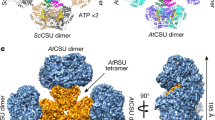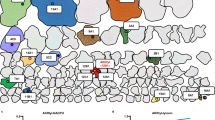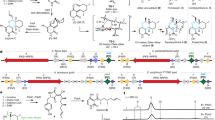Abstract
The first structure of an aldehyde dehydrogenase (ALDH) is described at 2.6 Å resolution. Each subunit of the dimeric enzyme contains an NAD-binding domain, a catalytic domain and a bridging domain. At the interface of these domains is a 15 Å long funnel-shaped passage with a 6 × 12 Å opening leading to a putative catalytic pocket. A new mode of NAD binding, which differs substantially from the classic β-α-β binding mode associated with the ‘Rossmann fold’, is observed which we term the β-α,β mode. Sequence comparisons of the class 3 ALDH with other ALDHs indicate a similar polypeptide fold, novel NAD-binding mode and catalytic site for this family. A mechanism for enzymatic specificity and activity is postulated.
This is a preview of subscription content, access via your institution
Access options
Subscribe to this journal
Receive 12 print issues and online access
$189.00 per year
only $15.75 per issue
Buy this article
- Purchase on Springer Link
- Instant access to full article PDF
Prices may be subject to local taxes which are calculated during checkout
Similar content being viewed by others
References
Lindahl, R. Aldehyde dehydrogenases and their role in carcinogenesis. Crit. Rev. Biochem. Mol. Biol. 27, 283–335 (1992)..
Lindahl, R. & Evces, S. Rat liver aldehyde dehydrogenase II: characterization of the four inducible enzymes. J. Biol. Chem 259, 11991–11996 (1984).
Jacoby, W.B. & Ziegler, D.M. Enzymes of detoxication. J. Biol. Chem. 265, 20715–20718 (1990).
Crow, K.E. & Hardman, M.J. In Human Metabolism of Alcohol. (eds K.E. Crow and R.D. Batts) 3–16 (CRC Press, 1989).
De Laurenzi, V. et al. Sjögren-Larsson syndrome is caused by mutations in the fatty aldehyde dehydrogenase gene. Nature Genetics 12, 52–57 (1996).
Cui, X., Wise, R.P. & Schnable, P.S. The rf2 nuclear restorer gene of male-sterile T-cytoplasm maise. Science 272, 1334–1336 (1996).
Tasayco, M.L. & Prestwich A specific affinity reagent to distinguish aldehyde dehydrogenases and oxidases. J. Biol. Chem. 265, 3094–3101 (1990).
McCaffery, P. & Dräger, U.C. Hot spots of retinoic acid synthesis in spinal cord developement. Proc. Natl. Acad. Sci. USA. 91, 7194–7197 (1994).
Racker, E. Actions and propertiesof pyridine-nucleotide linked enzymes. Phys. Rev. 35, 1–56 (1955).
Hempel, J., Vonbahr-Lindström, H. & Jörnvall, H. Aldehyde dehydrogenase from human liver: primary structure of the cytoplasmic enzyme. Eur. J. Biochem. 141, 21–35 (1984).
Habenicht, A., Hellman, U. & Cerff, R. Non-phosphorylating GAPDH of higher plants is a member of the aldehyde dehydrogenase superfamily with no sequence homology tophosphorylating GAPDH. J. Mol. Biol. 237, 165–171 (1994).
Brändén, C. & Tooze, J. Introduction to Protein Structure. (Garland, New York; 1991).
Rossmann, M.G., Moras, D. & Olsen, K.W. Chemical and biological evolution of a nucleotide binding protein. Nature 250, 194–199 (1974).
Holm, L. & Sander, C. Protein structure comparison by alignment of distance matrices. J. Mol. Biol. 233, 123–138 (1993).
Ghosh, D. et al. Three-dimensional structure of holo 3 alpha, 20 beta hydroxysteroid dehydrogenase: a member of the short chain dehydrogenase family. Proc. Natl. Acad. Sci USA 88, 10064–10068 (1991).
Hempel, J., Nicholas, H. & Lindahl, R. Aldehyde dehydrogenases: widespread structural and functional diversity within a shared framework. Prot. Sci. 2, 1890–1900 (1993).
von Bahr-Lindström, H. et al. Characterization of the coenzyme binding site of liver aldehyde dehydrogenase: differential reactivity of coenzyme analogs. Biochemistry 24, 5847–5851 (1985).
Hempel, J. & Pietruszko, R. Selective chemical modification of human liver aldehyde dehydrogenases by iodoacetamide. J.Biol. Chem. 256, 10889–10896 (1981).
Farrès, J. et al. Investigation of the active site cystine residue of rat liver mitochondrial aldehyde dehydrogenase by site-directed mutagenesis. Biochemistry 11, 2592–2598 (1995).
Blatter, E.E. et al. Chemical modification of aldehyde dehydrogenase by a vinyl ketone analogue of an insect phermone. Biochem. J. 272, 351–358 (1990).
Kitson, T.M., Hill, J.P. & Midwinter, G.G. Identification of a catalytically essential nucleophilic residue in sheep liver cytoplasmic aldehyde dehydrogenase. Biochem. J. 275, 207–210 (1991).
Wierenga, R.K., Terpstra, P. & Hol, W.G.J. Prediction of the occurance of the ADP-binding βαβ-fold in proteins, using an amino acid fingerprint. J. Mol. Biol. 187, 101–107 (1986).
Wilson, D.K., Bohren, K.M., Gabbay, K.H. & Quiocho, F.A. An unlikely sugar substrate site in the 1.65 Å structure of the human aldose reductase holoenzyme implicated in diabetic complications. Science 257, 81–84 (1992).
Hoog, S.S., Pawlowski, J.E., Alzari, P.M. & Penning, T.M. Three dimensional structure of rat liver 3a-hydroxysteroid/dihydroidol dehydrogenase: a member of the aldo-keto reductase superfamily. Proc. Natal. Acad. Sci. USA 91, 2517–2521 (1994).
Lesk, A.M. NAD-binding in dehydrogenases. Curr. Opin. Struct. Bio. 5, 775–783 (1995).
Bellamacina, C.R. The nicotinamide dinucleotide binding motif: a comparison of nucleotide binding proteins. FASEB J. 10, 1257–1269 (1996).
Hol, W.G., van Duijnen, P.T. & Berendsen, H.J.C. The alpha-helix dipole and the properties of protiens. Nature 273, 443–446 (1978).
Wierenga, R.K., De Maeyer, M.C.H. & Hol, W.G.J. Interaction of pyrophosphate moieties with a-helixes in dinucleotide binding proteins. Biochemistry 24, 1346–1357 (1985).
Ramakrishnan, C. & Ramachandran, G.N. Stereochemical criteria for polypeptide and protein chain conformation. Biophys. J. 5, 909–933 (1965).
Eklund, H., Samama, J.-P. & Jones, T.A. Crystallographic investigations of nicotinamine adenine dinucleotide binding to horse liver alcohol dehydrogenase. Biochemistry 23, 5982–5996 (1984).
Jones, K.H., Lindhahl, R., Baker, D.C. & Timkovich, R. Hydride transfer stereospecificity of rat liver aldehyde dehydrogenases. J. Bio. Chem. 262, 10911–10913 (1987).
Chan, M.K. et al. Structure of hyperthermophillic tungstopterin enzyme Aldehyde ferredoxin oxidoreductase. Science 267, 1463–1469 (1995).
Romao, M.J. et al. Crystal Structure of the xanthine oxidase-related aldehyde oxido-reductase from D. gigas. Science 270, 1170–1176 (1995).
Moore, S.A. & James, M.N.G. Structural refinement of the non-fluorescent flavoprotein from photobacterium leiognathi at 1.6 Å resolution. J. Mole. Biol. 249, 195–214 (1995).
Fisher, A.J. et al. Three-dimensional structure of bacterial luciferase from vibrio harveyi at 2.4 Å resolution. Biochemistry 34, 6851–6586 (1995).
Rose, J.P. et al. Preliminary Crystallographic analysis of class 3 rat liver aldehyde dehydrogenase. Proteins 8, 305–308 (1991).
Howard, A.J. et al. The use of an imaging proportional counter in macromolecular crystallography. J. Appl. Crystallogr. 20, 383–387 (1987).
Wang, B.-C. Resolution of phase ambiguity in macromolecular crystallography. Methods Enzymol. 115, 90–112 (1985).
Furey, W.F.J. & Swaminathan, S. Phases95: a program package for the processing and analysis of diffraction data from macromolecules. Methods Enzymol, in the press.
Jones, T.A. et al. Improved methods for building protein models in electron density maps and the location of errors in these models. Acta Crystallogr., A47, 110–119 (1991).
Engh, R.A. & Huber, R. Accurate bond and angle parameters for X-ray protein structure refinement. Acta Crystallogr. A47, 392–400 (1991).
Brünger, A.T., Karplus, M. & Petsko, G.A. Crystallographic refinement by simulated annealing: application to crambin. Acta Crystallogr. A45, 50–61 (1989).
Brünger, A.T. Free R value: A novel statistical quantity for assessing the accuracy of crystal structures. Nature 355, 472–475 (1992).
Laskowski, R.A. et al., PROCHECK: a program to check the Stereochemical quality of protein structures. J. Appl. Crystallogr. 26, 283–291 (1993).
Bernstein, F.C. et al., The protein data bank: a computer-based archive-file for macromolecular structures. J. Mol. Biol. 112, 535–542 (1977).
Luzzati, V. Traitement statistque des erreurs dans la determination des structures cristallines. Acta Crystallogr. 5, 802–810 (1952).
Kabsch, W. & Sander, C. Dictionary of protein secondary structure: Pattern recognition of hydrogen bonded and geometrical features. Biopolymers 22, 2577–2637 (1983).
Ferrin, T.E. et al. The MIDAS display system. J. Mol. Graphics 6, 13–27 (1988).
Kleywegt, G.J. & Jones, T.A. Detection, delineation, measurement and display of cavities in macromolecular structures. Acta Crystallogr. D50, 178–185 (1994).
Author information
Authors and Affiliations
Rights and permissions
About this article
Cite this article
Liu, ZJ., Sun, YJ., Rose, J. et al. The first structure of an aldehyde dehydrogenase reveals novel interactions between NAD and the Rossmann fold. Nat Struct Mol Biol 4, 317–326 (1997). https://doi.org/10.1038/nsb0497-317
Received:
Accepted:
Issue Date:
DOI: https://doi.org/10.1038/nsb0497-317
This article is cited by
-
Aldehyde dehydrogenase superfamily in sorghum: genome-wide identification, evolution, and transcript profiling during development stages and stress conditions
BMC Plant Biology (2022)
-
Structure and function of aldopentose catabolism enzymes involved in oxidative non-phosphorylative pathways
Biotechnology for Biofuels and Bioproducts (2022)
-
Pyrroline-5-carboxylate synthase senses cellular stress and modulates metabolism by regulating mitochondrial respiration
Cell Death & Differentiation (2021)
-
Biochemical Characterization of Phenylacetaldehyde Dehydrogenases from Styrene-degrading Soil Bacteria
Applied Biochemistry and Biotechnology (2021)
-
The Janus-like role of proline metabolism in cancer
Cell Death Discovery (2020)



